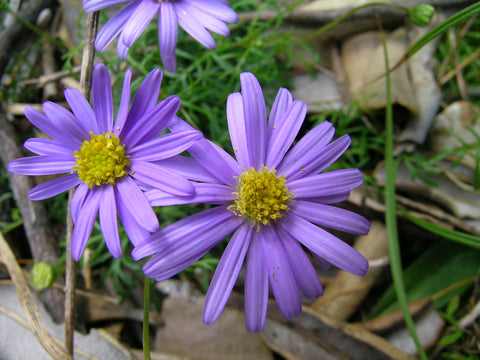10 Species of daisies to grow for flowers all summer long

Versatile Daisies
It represents innocence and, because it was believed to be Freya’s favourite flower, it symbolises motherhood and childbirth. One thing for sure, it is a beautiful flower in the garden, either for pots or borders.
When we think of daisies, we most often refer to the Ox-eye one: a rather large white flower with a yellow centre on a tall stem. The daisy family (Asteraceae) is actually a very large group of plants comprising of over 20,000 species of flowering plants.
So here are 10 species, early to late flowering, especially selected for an effortless WOW factor.
- Mexican Fleabane (Erigeron Karvinskianus): The foolproof one.

The Mexican Fleabane is a very attractive floriferous perennial. From April to November, it is covered in millions of tiny daisies with white or pink petals on the same plant. Vigorous and self-seeding, you will find it growing in crevasses and walls. Ideal in pots or in dry areas, it is quite forgiving even when neglected.
Aspect: Full Sun
Height and Spread: 0.3 x 0.9m.
Soil: Well-drained.
Flowering Season: April to November
- The Marguerite (Argyranthemum Frutescens): The All-time Favourite.

The Marguerite is actually an evergreen sub-shrub but it is often grown as an annual as it is tender (use winter protection, like a fleece, if the temperature drops below 0). It will flower abundantly throughout the summer, provided that you deadhead regularly. It comes in a wide range of colours: white, yellow, pink and red with a yellow to brownish centre. Stunning specimens for pots on their own, however, they also look beautiful in mixed planters with other summer beauties like the nemesia and the bacopa.
Aspect: Full Sun to partial shade
Height and Spread: 0.5 x 0.5m.
Soil: Well-drained.
Flowering Season: May to October.
- The Swan River Daisy (Brachyscome): the delicate.

This pretty annual is ideal for pots and baskets as it is covered in tiny daisies from June to October. Although, it is not a trailing plant as such, it tends to droop a little. The flower is similar to the Mexican fleabane in size but the finely cut, medium to dark green foliage makes the flowers to stand out. It comes in pink, purple and white, and looks particularly good with larger flowers like geraniums.
Aspect: Full Sun to partial shade
Height and Spread: 0.3 x 0.3m.
Soil: Well-drained.
Flowering Season: June to October.
- Chamomile: The edible

Let’s combine beauty with utility here. Like most herbs, the chamomile is very easy to grow, and its tea has many virtues. But did you know that there are actually different types?
The most common are the roman and the german ones. The Roman (Chamaemelum Nobile) is a low growing perennial that can be used as a lawn substitute. The German one (Matricaria Recutita) is a biennial. It grows taller and self-seeds.
Both varieties flower from June to August and are best grown in full sun to make the most of their fragrance. They are also both used for tea (relaxing and digestive).
Aspect: Full Sun
Height and Spread: 0.3 x 0.3m (Roman) / 0.6 x 0.3m (German)
Soil: Well-drained.
Flowering Season: June to October.
NB: The roman one is toxic to dogs and cats so it may be preferable to not grow it around young animals.
- Gerbera Garvinea: The large flowers for bouquets.

It is a must-have for anyone who is into flower arranging. This semi-evergreen perennial bears semi-double flowers, continuously from Late Spring until the first frosts. Floriferous with a good disease resistance, this variety will brighten up the front of the bed or the pots with its cheerful colours.
Aspect: Full Sun to partial shade
Height and Spread: 0.6 x 0.6m
Soil: Well-drained, moist and fertile.
Flowering Season: May to October.
- The African Daisy (Osteospermum): The Short and Colourful.

The African daisy has a long flowering season, it will bloom all summer long with regular deadheading and feeding, however, it is not fully hardy (except for the ’Juncundum’ type), so it is best grown as an annual. The vibrant colours of the flowers make great displays in pots and borders (at the front) in white, yellow, orange, and different shades of purple.
Aspect: Full Sun to partial shade
Height and Spread: 0.3 x 0.3m
Soil: Well-drained, moist, and fertile.
Flowering Season: June to October.
- Ox-Eye Daisy (Leucanthemum Vulgare): The wild Native One.

The oxeye daisy or Dog Daisy or Nóinín mór is making a comeback with the naturalist garden trend. Perfect in meadows where they grow naturally, they look very good with grasses and other tall plants like the verbena or the foxglove this biennial is easy to grow from seeds and very rewarding. Note that it is great addition to a pollinator-friendly garden, unfortunately it is toxic to pets so it should be kept away from puppies and kittens.
Aspect: Full Sun
Height and Spread: 0.4 x 0.3m
Soil: Well-drained
Flowering Season: June to August.
- Shasta Daisy (Leucanthemum x): The extravagant.

With its large flowers, fringed or double, white or yellow, the Shasta daisy is, without doubt, the most spectacular one. Growing up to 100cm (depending on the varieties) and fully hardy, they are a fantastic addition to any garden and an ally for the novice gardener as they are so easy to grow. Cottage, wild, romantic, or even contemporary, it suits almost any garden style.
Aspect: Full Sun
Height and Spread: Varies depending on the variety
Soil: Well-drained
Flowering Season: June to August.
- Aster (Symphyotricum): Stars in late summer

The flowers of the asters are very similar to the ones of the brachyscome. However, the commonly grown varieties are double flowered. You will find short varieties, ideal for pots and tall ones for borders. They are fantastic to help extending the summer vibe with romantic colours such as blues and purples which are in fashion for the last number of years.
Aspect: Full Sun to Partial shade
Height and Spread: Varies depending on the variety
Soil: Well-drained, moist and fertile
Flowering Season: August to October
- Black-Eyed Susan (Rudbeckia): Bright autumn colours

There is a huge range of Rudbeckias out there. The common trait: vivid autumn colours. From yellow to brown and even bicolour, warm colour lovers are spoilt for choice.
From 0.5 to 2m in high, depending on the variety, the rudbeckia is an ideal perennial for the border. For a very reliable variety, the ‘Goldsturm’ is a classic with its star shape yellow flowers with dark centres. Ideal for pots, the new hybrids ‘Sunbeckia’ will give you that WOW factor with their large flowers. Or, be tempted by the ‘Summerina’ range (a cross between the Echinacea and the Rubeckia) with its large bicolour petals.
Aspect: Full Sun to Partial shade
Height: 0.5 to 2m high depending on the varieties (most are around 0.6m)
Soil: Well-drained, moist and fertile
Flowering Season: August to October
Final words
To conclude, daisies are not only cheerful but also rather easy to grow and fairly low maintenance. There so many different varieties out there, it is virtually impossible to not find one that would lift your mood.
These are 10 varieties selected to suit even the beginners, but you could also try the Helenium, the Echinacea or the Coreopsis. Possibilities are endless.






Leave a comment